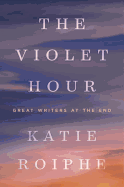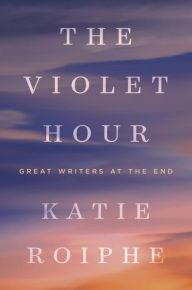
 Author and journalist Katie Roiphe (In Praise of Messy Lives) believes she conceived the idea for The Violet Hour when she was 12 years old and suffering a virulent form of pneumonia. Throughout her long convalescence, she developed an "endless appetite" for books about people dying. Roiphe turned to the comfort of literature to help deal with her experience; to understand and "see the world," she explains, she has "always opened a book." When Roiphe's father died of a massive heart attack years later, she decided to write The Violet Hour, which examines the last days of six famous writers and artists. Roiphe selected Susan Sontag, Sigmund Freud, John Updike, Dylan Thomas, Maurice Sendak and James Salter because each was "especially sensitive or attuned to death.... I've picked people who are madly articulate, who have abundant and extraordinary imaginations or intellectual fierceness, who can put the confrontation with mortality into words--and in one case images--in a way that most of us can't or won't."
Author and journalist Katie Roiphe (In Praise of Messy Lives) believes she conceived the idea for The Violet Hour when she was 12 years old and suffering a virulent form of pneumonia. Throughout her long convalescence, she developed an "endless appetite" for books about people dying. Roiphe turned to the comfort of literature to help deal with her experience; to understand and "see the world," she explains, she has "always opened a book." When Roiphe's father died of a massive heart attack years later, she decided to write The Violet Hour, which examines the last days of six famous writers and artists. Roiphe selected Susan Sontag, Sigmund Freud, John Updike, Dylan Thomas, Maurice Sendak and James Salter because each was "especially sensitive or attuned to death.... I've picked people who are madly articulate, who have abundant and extraordinary imaginations or intellectual fierceness, who can put the confrontation with mortality into words--and in one case images--in a way that most of us can't or won't."
Roiphe interviewed a host of people associated with each subject--wives, ex-wives, children, caretakers, friends, housekeepers, nurses--in order to grasp how each artist "faced or did not face, embraced or evaded, made peace with or raged against death, sometimes all at once." The harrowing section about writer Susan Sontag, who beat cancer two times and was challenged a third time with a terminal diagnosis, shows Sontag's ferocious will. She underwent aggressive treatments while intellectually rebelling against death. John Updike also endured grueling chemotherapy, and he chose to work feverishly on new poems about his experience. "He is writing his way out of death; he is dreaming his way past or through it." Similarly, Maurice Sendak worked through his obsessive "terror of death," taming it like a "dancing bear" that ultimately performed for him via his drawings and children's stories.
As Sigmund Freud neared his demise, he refused anything stronger than aspirin for his pain. He remained insistently willful and controlling--determined clearly to process and analyze every moment until his final breath. In contrast, young and healthy Dylan Thomas once referred to his poems as "statements made on the way to the grave." Thus, he flirted recklessly and often with his own demise. Ideas of death permeate much of his work.
In Roiphe's epilogue, a philosophical conversation with James Salter, a vibrant 89-year-old writer--a quintessential observer who claimed emotional detachment from death--encourages the author finally to circle back and address her own deep fears about mortality.
What Roiphe discovers by closely observing and contemplating each of her subjects in their darkest hours--especially their courage and great flourishes of creativity when at their most vulnerable--surprises her, and the insights she shares are bound to affirm in readers the value and meaning of life. --Kathleen Gerard, blogger at Reading Between the Lines
Shelf Talker: An in-depth exploration of the lives of six famous writers and artists who confronted the prospect of death via their art.

